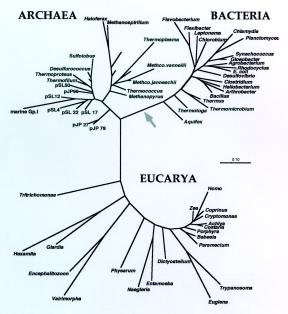Changed View of the BiosphereThis view of the biosphere has dramatically changed in the last decade with the advent of molecular taxonomy and phylogeny. The basic idea behind this approach is that there are some molecules common to all Earthly life (16 S ribosomal RNA, for example), and that, if one could sequence such molecules and compare the sequences, it might be possible to use this chemical information to compare all life, even that which can be seen only with a microscope. While the germ of this idea is actually decades old, its demonstration was realized only recently with new development of techniques in sequencing of nucleic acids, and the use of this information for organismic comparisons. The work pioneered by Dr. Karl Woese of the University of Illinois has
changed the way we look at life on Earth. A quick glance at the molecular tree reveals that the major genetic variation among the eukaryotes is seen in the single celled protists, while the three dominant kingdoms (plants, animals, and fungi) are actually clustered at the end of the eukaryotic assemblage, and display only a modicum of genetic diversity (see below). Apparently, it is possible to achieve structural and behavioral diversity (traits that have appeared only in the last 500 million years) while remaining genetically rather homogeneous. Given that multicellular eukaryotes evolved only recently, and that for nearly 3 billion years the prokaryotes dominated the surface of the Earth, one should not be surprised that the bulk of the apparent genetic diversity on the planet resides in this group.
Figure 4. The three kingdoms of life. Based on sequence analyses of the 16 S ribosomal RNA gene, which is contained in all Earthly organisms, it is possible to construct a molecular phylogeny that can quantitatively compare all organisms, even those that can not be cultivated in the laboratory. Such an approach has yielded quite a different view of life, as shown here, in which the major kingdoms of life (animals, plants, fungi, and protists) shown in Figure 3, are grouped into one kingdom, and the prokaryotes are expanded into two kingdoms, called the Archaea and the Bacteria.
Contributed by: Dr. Kenneth Nealson |
|
Source: Kenneth Nealson Related Media:
Other Resources:
|





